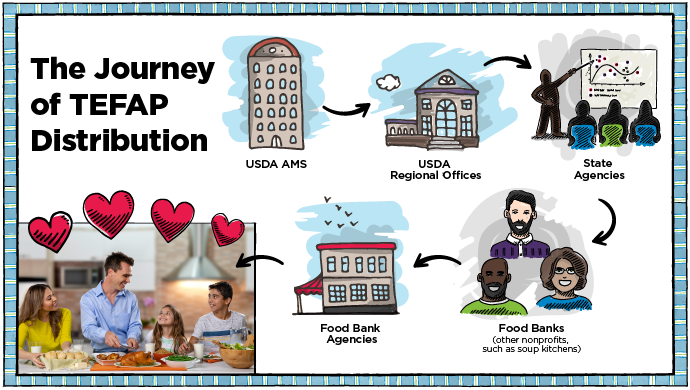The Emergency Food Assistance Program (TEFAP)
Why it Matters for Dairy
In July 2021, dairy was added to the Entitlement Catalog. Food banks can now use federal dollars to meet the needs of their network through dairy foods.
USDA Foods Available List for TEFAP
How the Program Works
The Emergency Food Assistance Program (TEFAP) is a federal program that helps supplement the diets of low-income Americans, including elderly people, by providing them with emergency food assistance at no cost.
Funding
This U.S. Department of Agriculture (USDA) program funding is adjusted each year through congressional appropriations. TEFAP funding for 2024 is estimated to be $463.75 million, plus up to $943 million in supplemental foods and operational expenses from the Commodity Credit Corporation.
Distribution
Through TEFAP, the USDA purchases a variety of nutritious, high-quality foods, including dairy foods like milk, cheese and yogurt, that are made available to state distributing agencies. States also receive administrative funds to support the storage and distribution of the program's foods.
- USDA determines food quantities for states based on the amount of people who are unemployed and whose incomes fall below poverty levels.
- States provide the food to select local agencies, usually food banks.
- Local agencies (i.e., food banks) distribute to local organizations, such as soup kitchens, food pantries or community action agencies.
- Local organizations (e.g., food pantries) distribute food to eligible recipients for household consumption or use them to prepare and serve meals in a congregate setting.

How to Participate
Food Banks, Food Pantries & Other Local Organizations
- Contact your State Distributing Agency to learn how to become a TEFAP local agency.
- Work with your state agency to modify your TEFAP contract and program agreement.
- Measure and calculate the amount of perishable milk you can accept and store on a regular basis.
- Develop a strategy and plan for distributing a high volume of perishable milk through your food bank network or nonprofit organization.
Current list of TEFAP food banks in the U.S.
Processors
- Become an approved USDA vendor. Vendor applications are accepted on a rolling basis; allow 3-4 weeks for approval.
- Find solicitations to purchase food, and sign up for email notifications for solicitations
- AMS uses two types of solicitations: Invitation for Bids (IFB) and Request for Proposals (RFP). Each solicitation describes USDA’s needs for product, volume, destination and delivery.
- Submit an offer to fill the demand.
- If application is accepted, a contract will be awarded.
- Provide food to local agencies as outlined in the bid or proposal.
- Submit an invoice following contract execution.
Additional Information
Dairy processors and food banks can and should communicate directly. Outline logistics in detail. Not all TEFAP state agencies share the same logistical information with food banks.
- Agree on how crates will be returned before service begins.
- Align on a delivery schedule. Not all food banks can handle the same delivery sizes. Generally, smaller and more frequent deliveries are easier to move.
- Many food banks and agencies have limited cold storage and refrigeration trucks. Solutions such as mobile pantries can help in urban/underserved regions.
- Securing funding for distribution support from USDA and the private sector is critical.
- Work together to share the impact of purchases, including program feedback.


